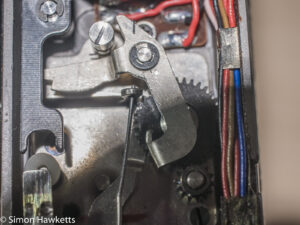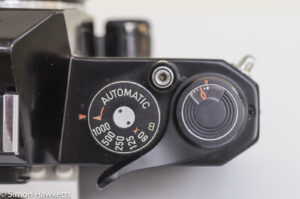Pentax Spotmatic ES 35 mm SLR review
This is a review of one of the later Pentax Spotmatic models and one of the first cameras to offer aperture priority auto exposure – the Pentax Spotmatic ES.
Pentax Spotmatic ES Images









My Pentax Spotmatic ES Camera
I must admit to having a bit of a passion for the Spotmatic models at the moment. Ever since I found my original spotmatic model a couple of weeks ago, I’ve been on the lookout for other models in the series, so I was really interested when I found a Spotmatic ES which was being sold for spares or repair with the same fault as that unit. It had taken only a couple of minutes to fix my Spotmatic, so I guessed the ES model could probably be fixed with the same ease, and I bought the camera for £15.
When I received it a couple of days later, I found a camera in reasonably good cosmetic condition, with just a few marks and areas of paint loss on the top and bottom plates. Because the normal colour of the ES model is black, as this one is, it makes marks more noticeable, but not annoyingly so.
When I tried the shutter I found that, just as the seller reported, the mirror would stay in the ‘up’ position more times than not, so I took the bottom off the camera to try to apply the same fix. Because the ES is an auto exposure camera there are more electronics, and they are fitted to a circuit board under the bottom cover, but they are actually very easy to remove because the whole board is held by a couple of screws and is pluggable. Once I’d removed the PCB, I found the actual mechanics were very similar to the original Spotmatic and the fix was equally easy to apply. A small drop of oil applied to the cog which controls the mirror release arm, and the camera was working like new again – at least regarding the mirror return.
Once I’d fixed the mirror and re-assembled the bottom plate, I had a closer look at the rest of the camera. The lens fitted was an Auto Optomax 35 to 70 mm zoom which wouldn’t allow the ES’s auto exposure to operate with open aperture metering, so I fitted a Super-Multi-Coated Takumar 55 mm f/1.8 which has the additional arm on the back of the lens to communicate the aperture setting to the body. With this in place, I tried the metering but found it was completely dead. “Probably the battery”, I thought, and turned the camera over to look in the battery compartment, only to find there isn’t one. At least, there isn’t one on the bottom of the camera (I really should have noticed this when I took the bottom cover off).
So I looked around and found that the battery on the ES model is fitted in the front of the camera, where the self-timer lever is traditionally fitted to 35 mm SLRs. I assumed I’d have to send for a battery but found that by coincidence it is the same unit as fitted to the Bronica ETRSi, and I’ve just bought a box of those, so I fitted one and tried again.
Unfortunately, the results were just about the same. The meter doesn’t work at all as far as I can see, and the shutter speed certainly isn’t responding to different light levels, so I still have another problem to fix. I know the battery isn’t the problem because the battery check button confirms that it is powering the camera. I’m going to get the bottom cover off again to see if there are any poorly soldered joints etc.
Fortunately, the electronic shutter isn’t absolutely required to test the camera with film or use it in manual mode, so I will still put a test film through the camera to check that everything else is OK.
Pentax Spotmatic ES Description
The Spotmatic ES was one of the later models in the spotmatic range and one of the few models which had automatic exposure control. The first version with auto exposure was the Electro Spotmatic, which was the precursor to the ES, but only available in Japan. That model had a reputation for some reliability issues which were addressed in the ES model which became a worldwide release. After a couple of years, the ES was superseded by the ESII model.
Because of the ES has additional electronics, it is slightly taller than the original Spotmatic because the bottom plate is bigger.
The Spotmatic was mostly made in chrome, with special order units made in black. For the ES, that was reversed, with most models being black and the special production units chrome. That is why the majority of ES models found today are black.
Exposure Control
As I said above, this version of the spotmatic has aperture priority automatic exposure control. This is engaged by selecting the new option ‘Automatic’ on the shutter speed dial, and setting the aperture on the lens. With this engaged, the camera will choose the correct shutter speed for the aperture selected and display the speed in the viewfinder on the right-hand side via a needle and scale. Although the scale in the viewfinder only goes down to 1 second, the camera is actually capable of setting any required speed between 8 seconds and 1/1000.
However, one way the Spotmatic ES is not as good as the original Spotmatic is with a reduced number of slow shutter speeds in manual mode. The slowest selectable speed is 1/60th sec, whereas the original camera had the full range of speeds from 1/60 down to 1 sec.
Another improvement the ES has over the original Spotmatic is that it allows open aperture metering as long as a lens which supports it is fitted. Open aperture metering means that the lens doesn’t need to actually reduce the amount of light coming into the camera in order to measure the exposure. The advantage of this of course is that the picture in the viewfinder remains bright irrespective of the aperture chosen. To support this feature, Pentax introduced the Super-Multi-Coated Takumar range of lenses, which have an additional lever on the back of the mount which transmits the aperture setting to the camera.
If the lens fitted doesn’t have this extra lever and therefore won’t support open aperture metering, the camera has a metering switch in the same position as the original Spotmatic and can use stop down metering instead.
Viewfinder
The viewfinder in the ES model is very similar to the original Spotmatic model. There is the same micro prism focusing aid with the Fresnel surround and ground glass screen, and the viewfinder looks as big and bright to me. The only real difference is that instead of the match needle meter on the right-hand side, there is a range of shutter speeds with the needle indicating the chosen one.
Impressions
I’ve had the ES model for a few days, and I’m impressed with the handling of it. It feels slightly heavier than the spotmatic, but the increase in size isn’t really noticeable at all. The quality of the mechanics is typically Pentax and even more typically Spotmatic with a really nice feel of using a great piece of engineering.
Although I can test the camera without the electronics working, I’m going to try to fix the auto exposure first because it’s going to be easier to do that without film in the camera.
Pentax Spotmatic ES Specs
- Pentax Spotmatic ES 35mm slr
- Open aperture metering with lens which supports it
- Stop down metering fall back
- Aperture priority auto exposure
- Manual exposure
- TTL metering in Aperture priority mode.
- Shutter speed 8 sec to 1/1000 in Auto mode
- Reduced Shutter range of 1/1000 to 1/60 + B in manual mode
- Viewfinder indicates shutter speed chosen in Auto mode
- Exposure Compensation of 1/2x, 2x, 4x
- Film type reminder
- Hot shoe flash socket + X & FP sockets
- M42 lens mount
- Pentax manuals available on-line here.
Discover more from Everything Vintage
Subscribe to get the latest posts sent to your email.








I have one of these with serial number exactly 90 below yours. i got it on ebay with a SPII and SMC 55 f1.8 it is completely mint not a mark on the black finish, I love it. Like you i am a big fan of spotamtics I have 14 of them now.